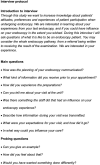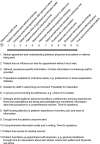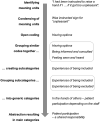Patient participation in gastrointestinal endoscopy - From patients' perspectives
- PMID: 32372493
- PMCID: PMC7495085
- DOI: 10.1111/hex.13066
Patient participation in gastrointestinal endoscopy - From patients' perspectives
Abstract
Background: Patient participation is associated with satisfaction and improved health-related outcomes. In gastrointestinal endoscopy, patient participation is an underexplored area.
Objective: To gain understanding on patients' experiences, attitudes and preferences concerning patient participation in the endoscopy pathway.
Methods: Semi-structured interviews with endoscopy patients (n = 17, female n = 8, male n = 9, ages 19-80 years) were performed. Interview transcripts were analysed using qualitative content analysis. Participants were recruited by purposive sampling from an endoscopy unit in a Swedish university hospital. Inclusion:≥ 18 years, fluency in Swedish and recent experience of endoscopy at the unit.
Results: Five generic categories emerged, two within the area of the patient's role, which was described as active or passive/included or excluded. Another three generic categories related to factors, critical to active participation, including organizational aspects, impressions of staff and individual circumstances were identified. In this context, patient participation described in the interviews was on a low to basic level, although sometimes reaching a higher level when staff 'invited' patients in decision making.
Discussion: This study contributes to the understanding of patient participation in endoscopy. Patients are in an inferior position and need support from the staff for an active role in their care. Although there were variations on the perceived importance of different factors, a heavy responsibility lies on the endoscopy staff to acknowledge the patients' individual needs and to facilitate patient participation.
Conclusions: Endoscopy staff has a key role in supporting patient participation. In endoscopy settings, patient participation is vulnerable to multiple factors.
Keywords: attitudes; colonoscopy; communication; endoscopy; gastrointestinal; gastroscopy; health knowledge; patient participation; patient-centred care; practice; professional-patient relations; qualitative research; sigmoidoscopy.
© 2020 The Authors. Health Expectations published by John Wiley & Sons Ltd.
Conflict of interest statement
The authors declare no conflict of interest.
Figures
References
-
- Institute of Medicine Committee on the Health Professions Education S In: Greiner AC, Knebel E. eds. Health Professions Education: A Bridge to Quality. Washington, DC: National Academies Press (US); 2003. The Core Competencies Needed for Health Care Professionals. Availablefrom: https://www.ncbi.nlm.nih.gov/books/NBK221519/ - PubMed
-
- Beauchamp TL, Childress JF. Principles of Biomedical Ethics, 7th ed New York, NY: Oxford University Press; 2013.
-
- Schiffinger M, Latzke M, Steyrer J. Two sides of the safety coin?: How patient engagement and safety climate jointly affect error occurrence in hospital units. Health Care Manage Rev. 2016;41(4):356‐367. - PubMed
-
- McMillan SS, Kendall E, Sav A, et al. Patient‐centered approaches to health care: a systematic review of randomized controlled trials. Med Care Res Rev. 2013;70(6):567‐596. - PubMed
Publication types
MeSH terms
LinkOut - more resources
Full Text Sources




